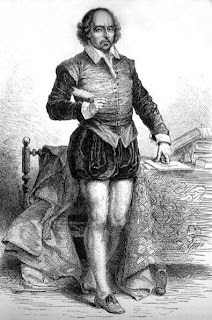In 1989, workmen constructing an office building on Bankside unearthed the remains of one of London’s earliest theatres after The Globe. These remains came under threat, until a campaign to save the site was launched, and thus the building was suspended, leaving the theatre’s remains conserved underneath, kept dark to prevent algae growth and covered in sand, cement and water.
During excavation, the
theatre was discovered to be polygonal, with a yard that sloped forwards; the
stage itself unexpectedly shallow and tapering at the sides. The Museum of
London staff found more than 700 small objects which are now housed in the
museum, including jewellery, coins, tokens and fragment of the money boxes used
to collect entrance fees from the audience.
 |
| The Rose Theatre, Bankside |
Portions of the
theatre's foundations, under the ingressi (wooden stairs leading to the
galleries), were found to be littered with fruit seeds and hazelnut shells. When
combined with cinder and earth, these shells provided a tough floor surface -
so tough, that 400 years later archaeologists had to take a pick axe to it to
penetrate it.
The hazelnuts were probably not eaten, the nutshells being
brought to the site from a nearby soapworks, where the kernels were crushed for
their oil.
Plans are in place to
complete the excavation and open it to the public permanently, in the meantime
there is an exhibition, accessed from Park Street.
Building of The Rose
Bankside in the late
16th Century was the area south of the River Thames reached by the old London
bridge, notorious for its brothels, bull and bear baiting arenas and gambling
dens.
Little Rose was the
name of a boggy area that contained substantial rose gardens and two buildings,
leased by Philip Henslowe, a property developer from the parish of St. Mildred, whose business investments included starch-making and pawn-broking.
Together with a grocer
named John Cholmley, and a carpenter called John Griggs, Henslowe built the
first purpose-built playhouse to stage a production of Shakespeare's plays in
1587.
Cholmley used one of
the buildings as a storehouse, while Henslowe leased the other as a brothel.
The new theatre was a fourteen-sided polygon of about 72 feet in diameter,
constructed of timber, with a lath and plaster exterior and thatched roof.
This was the fourth
public theatre after The Red Lion, [1657] The Theatre [1576], the Curtain
[1577], and the one at Newington Butts [1580]. Building these playhouses in
Southwark put them outside the jurisdiction of the City of London's civic
authorities.
These were open-air
"public" theatres who charged a penny paid for entry. The three other
London theatres, Blackfriars [1599], the Whitefriars [1608] and the Cockpit
[1617], and the Salisbury Court Theatre [1629] near the site of the defunct
Whitefriars were smaller, enclosed buildings for smaller audiences and charged
more for entry.
In 1592, Henslow’s
step-daughter married the actor Edward Alleyn and by 1593, Alleyn was
associated with two theatre companies, Lord Strange's Men and the Admiral's Men
who staged performances at The Rose. Alleyn certainly performed the roles of Tamburlaine
and Doctor Faustus, and he probably also played Barabas in The Jew of Malta.
The Rose soon needed enlarging to allow
another five hundred spectators. This enlargement work was done by the builder John
Grigg, who gave the theatre its distorted shape, described as ‘bulging tulip’.
Between 1592–4, severe
outbreaks of bubonic plague closed the London theatres, so the companies were
forced to tour to survive. Some, like Pembroke's Men, fell on hard times. By
the summer of 1594 the plague had abated, and the companies re-organized
themselves, principally into the Lord Chamberlain's Men and the Admiral's Men.
The latter troupe, still led by the actor Edward Alleyn, resumed residence at
the Rose.
Henslowe kept
meticulous accounts and diaries during his management of the theatre company,
including the costs of costumes and payments to playwrights, and the licensing fees to
the Master of the Revels. He mentions in his
diaries a lady he refers to as, ‘Black Luce’ who was one of his tenants and
apparently kept a brothel.
Lucy’s name appeared
in a number of texts, including the ‘Gray's Inn Christmas Festivities’ when the students ruled the Inn for the day,
appointing a Lord of Misrule called the Prince of Purpoole. Shakespeare performed at the Inn at
least once, as his patron, Lord Southampton was a
member.
Perhaps Shakespeare
knew of Lucy through her acquaintance to Henslowe and The Rose,
which could indicate she may have been the mysterious ‘Dark Lady’, Shakespeare
mentions in his plays. His sonnets, Nos 127-154, are known as the “Dark Lady”
sonnets where the poet mentions a mysterious woman with black hair and
"raven black" eyes. Phebe in As You Like it, says
"He said mine eyes were black and my hair black"
However, there
was more than one dark lady in London during the late 16th century,
so who knows, but these are interesting coincidences.
The repertory who
played at The Rose included Christopher Marlowe’s Doctor Faustus, Jew of Malta and
Tamburlaine the Great, Kyd’s Spanish Tragedy and Shakespeare’s Henry VI part I
and Titus Andronicus.
Prompted by complaints
from city officials, the Privy Council decreed in June 1600 that only two
theatres would be allowed for stage plays: The Globe Theatre on Bankside, and
the Fortune Theatre in Middlesex Thus the Rose fell out of use and by 1606 was
abandoned as a theatre as the lease had run out, so was most probably demolished.
Museum of London
Anita's Blog
Anita Davison is a Historical Fiction Author whose latest release, ‘Royalist Rebel’ a biographical novel set in 17th Century England, is released by Claymore Books under the name Anita Seymour
Anita's Blog
Anita Davison is a Historical Fiction Author whose latest release, ‘Royalist Rebel’ a biographical novel set in 17th Century England, is released by Claymore Books under the name Anita Seymour




